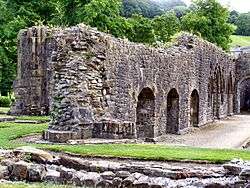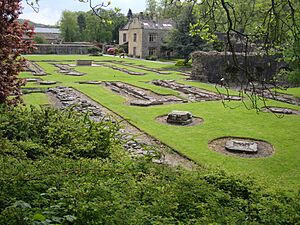Whalley Abbey facts for kids
Quick facts for kids Whalley Abbey |
|
|---|---|

Ruins of Whalley Abbey's claustral buildings
|
|
| OS grid reference | SD 730 361 |
|
Listed Building – Grade I
|
|
| Designated | 13 February 1967 |
| Reference no. | 1164643 |
| Reference no. | 1008636 |
| Lua error in Module:Location_map at line 420: attempt to index field 'wikibase' (a nil value). | |
Whalley Abbey is an old monastery in Whalley, Lancashire, England. It was once home to Cistercian monks.
After King Henry VIII closed many monasteries in England, Whalley Abbey was mostly pulled down. A large house was then built on the site. In the 1900s, this house was changed. Today, it is a special place for meetings and quiet reflection for the Diocese of Blackburn.
The old ruins of the abbey are very important. They are listed as a Grade I building and are a Scheduled Ancient Monument. This means they are protected because of their history.
Contents
History of Whalley Abbey
The Monastery's Story
In 1296, a group of Cistercian monks moved to Whalley. They came from Stanlow Abbey, which was near the River Mersey. Stanlow Abbey had a lot of bad luck. It flooded in 1279, its church tower fell in a storm in 1287, and a fire happened in 1289.
So, in 1283, Henry de Lacy, a powerful baron, agreed that the monks could move. But it took until 1296 for them to actually move to Whalley. The first stone of the new abbey was laid in June 1296. Part of the site was blessed in 1306.
Building the abbey was a very slow process. The main foundation stone was laid in 1330. The monks got stone from quarries in Read and Simonstone. In 1339, they got permission to build a strong, fortified wall around the abbey.
The church part of the abbey was finished in 1380. But the rest of the buildings weren't done until the 1440s. In 1480, a new entrance gatehouse was built. In the 1500s, John Paslew, who was the last leader (Abbot) of Whalley, rebuilt his own rooms and added a Lady Chapel.
The abbey closed in 1537. This was part of a big event called the dissolution of the monasteries. During this time, King Henry VIII closed all monasteries in England. That same year, Abbot Paslew faced serious trouble and was executed after a big protest called the Pilgrimage of Grace.
From Abbey to Private Home
In 1553, the abbey lands and the area of Whalley were sold. They were bought by John Braddyll and Richard Assheton for just over £2,151. The land was split between them. Richard Assheton took the abbey site and its buildings.
The abbot's house and the infirmary (where sick monks were cared for) were pulled down. A large new house was built in their place. In the 1600s, most of the remaining church and monastery buildings were also taken down.
The house was owned by different families over the years. More changes were made to it in the 1800s. Around 1900, Sir John Travis Cragg bought the house and its grounds.
A Modern Religious Place
In 1923, the house and grounds were bought by the Anglican Diocese of Manchester. The bishop at that time was William Temple. When the diocese was split in 1926, the property went to the new Diocese of Blackburn.
In 1930, Canon J. R. Lumb became the first leader of the centre. Since then, it has become a place for religious education. It also has rooms where guests can stay. Two rooms on the ground floor have been turned into chapels. In the 1930s, people dug up the site of the old abbey church. They found the original foundations and made sure they were protected.
Whalley Abbey Today
Retreat and Conference House
The old private house is now a place for retreats and conferences. It was updated and reopened in September 2005. It has rooms for meetings, a dining room, and guest rooms with their own bathrooms.
In the north part of the building, there is a visitor centre. This centre has a coffee shop, a place to see exhibitions, and a bookshop. People can also join in a special program for spiritual learning, whether they are staying there or just visiting. In the summer, you can arrange guided tours to explore the abbey ruins.
Abbey Ruins and Grounds
Today, only the foundations of the main church remain. But more parts of the other old monastery buildings are still standing.
- The west range, which was where the lay brothers (monks who did manual work) slept, still has two stories and a roof. This part is now used as a Roman Catholic church hall.
- To the south of the cloister (the open courtyard), some walls of the old kitchen and dining hall (refectory) can still be seen.
- The east range is more complete. It includes parts of the walls from the monks' day room, parlor, and vestry (a room for church clothes).
Other Buildings Nearby
The North West Gateway, which is another old gatehouse, is also very important and listed as Grade I. It is made of sandstone and has two stories, but no roof. It is also a Scheduled Ancient Monument.
The lodge at the entrance to the abbey grounds is listed as Grade II. It was probably built in the late 1700s. It is made of smooth sandstone and has a stone roof. Also listed as Grade II are a pair of gateposts at the entrance to the grounds.
Images for kids



